According to Japanese automotive supplier, NSK, its engineers have successfully demonstrated the world’s first transmission-equipped wheel hub motor in a “breakthrough development” intended to improve the safety, comfort and environmental performance of vehicles.
The diverse range of drive systems being developed for next-generation vehicles, such as hybrid electric (HEV), electric (EV) and fuel cell (FCV), means that the potential of in-wheel motors that are able to function with all these various drive systems independent of vehicle body structure, is drawing attention.
An in-wheel motor can reduce vehicle weight through eliminating the need for an engine and other power transmission components, enable increased cabin space, and enable the drive force at each wheel to be controlled independently (similar to torque vectoring).
The major challenge to date has been achieving the drive torque necessary for acceleration and hill climbing, as well as a sufficient maximum speed. To solve these challenges, NSK has developed a transmission-equipped wheel hub motor that uses two independent motors and a special transmission. The transmission comprises two planetary gears that can deliver both high drive torque and a sufficient maximum speed using a motor which is able to fit inside a 16in wheel.
According to NSK, notable functionalities of the transmission include smooth gear changing, even during acceleration, which is achieved by controlling the speed and torque of the two motors. In high gear motion, the shifting mechanism sees the motors revolve in the same direction. Conversely, when low gearing is required, the motors revolve in opposite directions.
The NSK demonstration is claimed to have provided evidence of this performance using an experimental vehicle equipped with a prototype wheel hub motor. Following on from the prototype demonstration, NSK will now seek to commercialize specific components, including the wheel hub unit bearing with integrated speed reducer, and a one-way clutch unit. The company will also develop the miniature cage and roller bearing, as well as the anti-corrosion bearing, making them ready for production applications.




